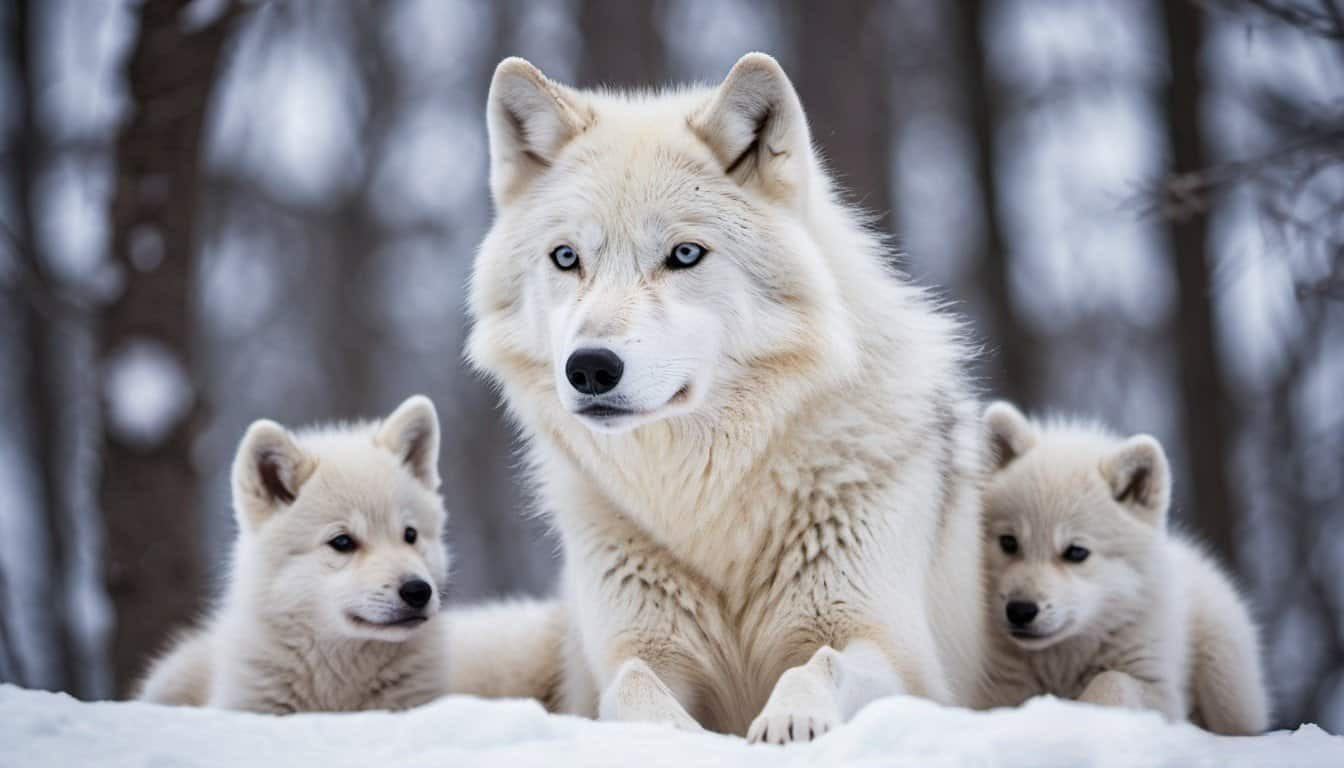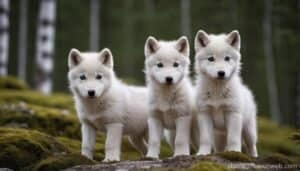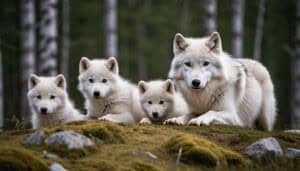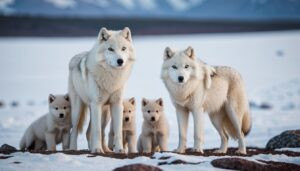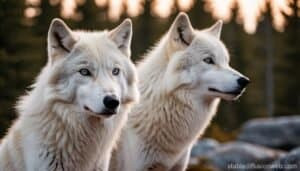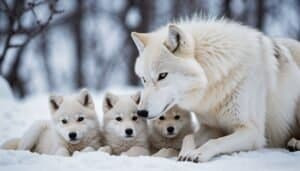Introduction
The Arctic wolf, a subspecies of the gray wolf, thrives in the harsh conditions of the Arctic. This article explores the gestation period of Arctic wolves, providing insights into their reproductive cycle and the challenges they face
We will delve into the average length of gestation, compare it with other wolf species, and examine factors that influence it. Additionally, we will discuss the birth and care of wolf pups, highlighting the stages of pregnancy and the role of the pack in supporting the mother and her offspring
Average Gestation Period For Arctic Wolves
The gestation period of Arctic wolves is a fascinating aspect of their biology. Like other canids, Arctic wolves have a well-defined reproductive cycle that ensures the survival of their species in the challenging Arctic environment
Comparison With Other Wolves
The gestation period of Arctic wolves is typically about 63 days, similar to other subspecies of the gray wolf. This period can range from 61 to 64 days, depending on various factors, including environmental conditions and the health of the female wolf
While this duration is consistent with other wolf species, the timing of breeding and birth in Arctic wolves is uniquely adapted to their environment
In comparison, other gray wolf subspecies, such as the timber wolf or the Eurasian wolf, also have a gestation period of about 63 days. However, their breeding season may vary slightly
For instance, timber wolves usually breed from January to March, while Arctic wolves often breed from late February to March. This slight variation ensures that the birth of pups aligns with the best possible conditions for their survival.
Factors Influencing Gestation Period
Several factors influence the gestation period of Arctic wolves. One of the primary factors is the harsh Arctic climate. The breeding season is timed so that pups are born during the spring when temperatures are milder, and food is more abundant. This timing increases the chances of pup survival, as they are born into a more hospitable environment
Another significant factor is the health and nutrition of the mother wolf. Adequate nutrition is crucial during pregnancy to ensure the health and development of the pups
In the Arctic, where food can be scarce, the condition of the mother wolf can directly impact the length and success of the gestation period. Malnourished or stressed mothers may experience complications that could affect the pregnancy duration and the health of the newborn pups
Moreover, genetic factors and the age of the mother wolf can also play a role. Younger and older wolves might experience slightly different gestation periods compared to wolves in their prime reproductive age. Younger wolves, having their first litter, may have less predictable gestation lengths, while older wolves might face complications that could influence the timing of birth
Birth And Care Of Arctic Wolf Pups
The birth and care of Arctic wolf pups are critical for the continuation of the species in the challenging Arctic environment. The process, from conception to weaning, involves several stages and requires the collective effort of the pack to ensure the pups’ survival
Typical Litter Size
Arctic wolves typically give birth to litters ranging from 2 to 4 pups, though it is not uncommon to see litters of up to 6 pups in favorable conditions
The size of the litter can be influenced by various factors, including the health and age of the mother, environmental conditions, and the availability of food resources. Larger litters generally indicate a healthy mother and an abundant food supply, while smaller litters may reflect harsher conditions or a less experienced mother
Stages Of Pregnancy
The pregnancy of an Arctic wolf progresses through several stages. After the breeding season, which occurs between late February and March, the fertilized eggs undergo a period of implantation in the uterine wall
This initial stage is crucial as it sets the foundation for the developing embryos. Following implantation, the embryos begin to grow and develop rapidly, with key organs and structures forming during the first few weeks
As the pregnancy progresses, the mother’s body undergoes noticeable changes. She will start to gain weight and may become more protective and less active as she prepares for the birth. During the final weeks of pregnancy, the mother wolf will seek out a suitable den site
These dens are typically located in sheltered areas, such as caves, rock crevices, or dug-out burrows, providing protection from the harsh Arctic weather and predators
Post-Birth Care
Once the pups are born, they are entirely dependent on their mother and the pack for survival. Newborn pups are born blind, deaf, and unable to regulate their body temperature, making them extremely vulnerable. During the first few weeks, the mother remains in the den, nursing and caring for the pups, while the rest of the pack provides food and protection
The mother wolf produces a rich milk that sustains the pups during their early weeks. As the pups grow, they will begin to open their eyes and ears, becoming more aware of their surroundings. Around three to four weeks of age, the pups start to venture out of the den, exploring their environment under the watchful eyes of the pack members
The role of the pack is crucial during this stage. Pack members, including the father and other subordinate wolves, take turns bringing food to the den and regurgitating it for the mother and pups. This cooperative behavior ensures that the mother can stay with the pups during their most vulnerable period while still receiving the nutrition she needs
As the pups continue to grow, they are gradually weaned off their mother’s milk and introduced to solid food. This transition period is essential for their development, as it prepares them for hunting and survival in the Arctic environment. By the time they are about eight weeks old, the pups are fully weaned and begin to follow the pack on hunting excursions, learning vital survival skills
Challenges Faced During Gestation
The gestation period for Arctic wolves is fraught with challenges that can impact both the mother and her developing pups. These challenges arise from the harsh environment of the Arctic, the dynamics within the pack, and the overall survival strategies that the wolves employ
Environmental Challenges
One of the most significant challenges during the gestation period is the extreme Arctic climate. Temperatures can plunge to dangerously low levels, and severe weather conditions, such as blizzards and ice storms, are common
These harsh conditions can affect the mother’s health and the development of the pups. For instance, finding adequate shelter and maintaining body warmth are crucial for the mother’s survival and the successful development of the fetuses
Food scarcity is another major environmental challenge. The Arctic is characterized by limited food resources, particularly during the winter months when prey animals are less abundant and harder to catch
Pregnant wolves require increased nutrition to support the growth of their pups, and a lack of sufficient food can lead to malnourishment, affecting both the mother and her developing offspring. This scarcity can also lead to higher stress levels, which can complicate the pregnancy
Role Of The Pack
The social structure and dynamics of the pack play a crucial role in the gestation period. Arctic wolves live in close-knit family groups, and the support of the pack is vital for the successful rearing of pups
The alpha pair, typically the dominant male and female, are usually the primary breeders within the pack. The other pack members, including subordinate wolves, play supportive roles by hunting for food, protecting the den site, and helping care for the pups once they are born
However, pack dynamics can sometimes pose challenges. Competition within the pack for resources or status can lead to conflicts that stress the pregnant female
Additionally, if the pack size is small or the members are not well-coordinated, the support provided to the pregnant female may be insufficient. This lack of support can lead to difficulties in finding food and protecting the den site, both critical for a successful gestation period
Survival Strategies For Pups
The survival of Arctic wolf pups depends on several strategies that the pack employs to overcome the environmental and social challenges they face
One key strategy is timing the birth to coincide with the spring thaw when temperatures are milder, and food becomes more plentiful. This timing ensures that the pups are born into an environment that offers the best possible chances for their survival
Another strategy is the selection of den sites. The mother wolf will choose a den that provides maximum protection from the elements and predators. These dens are often well-hidden and difficult to access, providing a safe haven for the newborn pups during their most vulnerable early weeks
The pack’s cooperative hunting behavior is also crucial. By hunting in groups, Arctic wolves can take down larger prey and increase their overall food intake, which is essential for supporting the pregnant female and, later, the growing pups
This cooperative effort extends to caring for the pups, with all pack members playing a role in feeding, guarding, and teaching the young wolves survival skills
Conclusion
The gestation period of Arctic wolves is a complex and fascinating process that showcases the incredible adaptability and resilience of these animals in one of the world’s most extreme environments. Typically lasting around 63 days, this period is influenced by various factors including environmental conditions, the health and nutrition of the mother, and the cooperative dynamics within the pack
Arctic wolves face numerous challenges during gestation, from extreme weather conditions and food scarcity to the need for careful selection of den sites and the support of the pack. The birth and care of the pups are marked by a high degree of cooperation among pack members, ensuring that the mother and her offspring receive the necessary protection and sustenance
From the initial stages of pregnancy to the early weeks of the pups’ lives, each aspect of the reproductive cycle is geared towards maximizing the chances of survival in the harsh Arctic environment. The ability of the pack to work together, hunt efficiently, and protect their young is crucial to the continuation of the species
